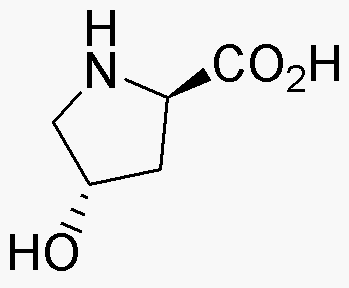trans-D-4-Hydroxyproline is widely utilized in research focused on:
- Pharmaceutical Development: This compound is a key building block in the synthesis of various pharmaceuticals, particularly those targeting collagen-related disorders, enhancing drug efficacy and stability.
- Protein Engineering: It is used to modify proteins, improving their stability and functionality. Researchers incorporate it into peptides to study its effects on protein folding and structure.
- Cosmetic Formulations: The compound is incorporated into skincare products for its moisturizing properties and ability to promote skin elasticity, making it valuable in the beauty industry.
- Biotechnology: In tissue engineering, it serves as a scaffold material, aiding in the development of biomaterials that support cell growth and tissue regeneration.
- Food Industry: It is utilized as a food additive to enhance texture and nutritional value, particularly in protein-rich products, catering to health-conscious consumers.
General Information
Properties
Safety and Regulations
Applications
trans-D-4-Hydroxyproline is widely utilized in research focused on:
- Pharmaceutical Development: This compound is a key building block in the synthesis of various pharmaceuticals, particularly those targeting collagen-related disorders, enhancing drug efficacy and stability.
- Protein Engineering: It is used to modify proteins, improving their stability and functionality. Researchers incorporate it into peptides to study its effects on protein folding and structure.
- Cosmetic Formulations: The compound is incorporated into skincare products for its moisturizing properties and ability to promote skin elasticity, making it valuable in the beauty industry.
- Biotechnology: In tissue engineering, it serves as a scaffold material, aiding in the development of biomaterials that support cell growth and tissue regeneration.
- Food Industry: It is utilized as a food additive to enhance texture and nutritional value, particularly in protein-rich products, catering to health-conscious consumers.
Documents
Safety Data Sheets (SDS)
The SDS provides comprehensive safety information on handling, storage, and disposal of the product.
Product Specification (PS)
The PS provides a comprehensive breakdown of the product’s properties, including chemical composition, physical state, purity, and storage requirements. It also details acceptable quality ranges and the product's intended applications.
Certificates of Analysis (COA)
Search for Certificates of Analysis (COA) by entering the products Lot Number. Lot and Batch Numbers can be found on a product’s label following the words ‘Lot’ or ‘Batch’.
*Catalog Number
*Lot Number
Certificates Of Origin (COO)
This COO confirms the country where the product was manufactured, and also details the materials and components used in it and whether it is derived from natural, synthetic, or other specific sources. This certificate may be required for customs, trade, and regulatory compliance.
*Catalog Number
*Lot Number
Safety Data Sheets (SDS)
The SDS provides comprehensive safety information on handling, storage, and disposal of the product.
DownloadProduct Specification (PS)
The PS provides a comprehensive breakdown of the product’s properties, including chemical composition, physical state, purity, and storage requirements. It also details acceptable quality ranges and the product's intended applications.
DownloadCertificates of Analysis (COA)
Search for Certificates of Analysis (COA) by entering the products Lot Number. Lot and Batch Numbers can be found on a product’s label following the words ‘Lot’ or ‘Batch’.
*Catalog Number
*Lot Number
Certificates Of Origin (COO)
This COO confirms the country where the product was manufactured, and also details the materials and components used in it and whether it is derived from natural, synthetic, or other specific sources. This certificate may be required for customs, trade, and regulatory compliance.


